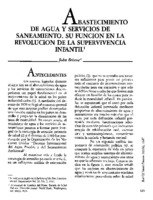Abastecimiento de agua y servicios de saneamiento : Su funcion en la revolucion de la supervivencia infantil
| dc.contributor.author | Briscoe, John | es_ES |
| dc.date.accessioned | 2015-12-08T03:11:36Z | |
| dc.date.available | 2015-12-08T03:11:36Z | |
| dc.date.issued | s.d. | es_ES |
| dc.date.issued | 1987 | es_ES |
| dc.identifier.uri | https://iris.paho.org/handle/10665.2/17947 | |
| dc.description.abstract | It has been argued that investments in water supply and sanitation should not be a major element of primary health care because these are not cost-effective health investments. This article demonstrates that the methodology used to arrive at this conclusion is systematically biased against water supply and sanitation; that such investments may be important for health even if the direct effects are modest; that the long-run effects; and that, these factors not withstanding, the short-run impacts of water supply and sanitation improvements on health are usually substantial | en_US |
| dc.format.extent | ilus | es_ES |
| dc.relation.ispartofseries | Boletín de la Oficina Sanitaria Panamericana (OSP);103(4),oct. 1987 | es_ES |
| dc.subject | Abastecimento de Água | pt_BR |
| dc.subject | Saneamento | es_ES |
| dc.subject | Mortalidade Infantil | pt_BR |
| dc.subject | Atenção Primária à Saúde | pt_BR |
| dc.subject | Expectativa de Vida | es_ES |
| dc.title | Abastecimiento de agua y servicios de saneamiento : Su funcion en la revolucion de la supervivencia infantil | es_ES |
| dc.title.alternative | A role for water supply and sanitation in the child survival revolution | en_US |
| dc.type | Journal articles | en_US |
| dc.rights.holder | Pan American Health Organization | en_US |
Files in this item
This item appears in the following Collection(s)
-
Pan American Journal of Public Health
Revista Panamericana de Salud Pública



